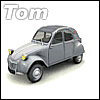mep wrote:Yes but more load on the front tires should also increase the friction witch is needed to steer.
Good point. You can see the article "The Traction Budget" by Beckman. Yes, I know, I recommend it once a week.
Tom wrote:Not sure if this has anything to do with CoG, but I know the lower the weight, the lower the CoG making rolling less likely (why boy racers lower their cars, but they don't understand this and just say it helps)
Tom's karting friends have got it right without any formulas:
lowering the center of gravity improves your braking, accelerating and cornering ability. The rolling "needs" are not as important for an F-1 as they are for an SUV. The rolling motion also causes weight shifting laterally, but there are mechanisms for improving the rolling attitude, mainly the anti-roll bars. This makes the entire tuning of CoG and suspension an art.
You can see
Beckman's article on weight shifting or
Wikipedia article on car handling and a link page on
vehicle dinamics where it is explained. I also wrote
something about this and roads.
There are some figures about the "ideal" weight distribution
if you take in account the typical road you will encounter (a point discussed elsewhere with DaveKillens). The Wikipedia article I mentioned (and that I found recently) has a funny section on "Cars with unusual handling problems" that goes a little on this direction. There is also a
"quick set-up guide" for race-cars that exemplifies front/rear weight distribution effects.
The front/rear weight distribution is a point argued about
since the times of King Tutankhamon which, by the way, died in what could be qualified as a racing accident. Take a look at
his fine gold and black chariot (Jhon Player Special?), ironically found in his tomb (it would be as Fangio buried with his car

).
You can even take a look at the egiptian monocoque developed for his Majesty that I cannot resist to post, (yes, I know I am a little off-thread, but for this type of vehicles the CoG distribution was critical

). And, yes, they have monocoques, antiroll bars AND suspension embedded in the chassis itself (the beams of the chassis itself were the springs, something F1 has not think of, yet). They could not integrate the horse and the chassis, but I think they tried...

It has been said that this thing "... surpass all monumental structures of the pharaohs in engineering sophistication."

You can find also a really good acceleration/deceleration simulator by
Lateral Visions..
The
Bugatti 35 and the
Lotus Seven are mentioned frequently by racers and designers (not that I have handled one!

) as "ideal" race cars from the point of view of balancing everything, including weight distribution.
Some racer friends think that weight distribution and football (soccer for the americans) forward/defense distribution are like a blanket that it is too short: if you cover your neck, your feet become exposed.






